Ever wondered how a simple drawing can transform your kitchen into a dream space? Kitchen layout drawings are incredibly popular because they help visualize and plan how your kitchen will function—making sure everything flows effortlessly and suits your lifestyle. Whether you’re redesigning an existing space or starting fresh, a well-thought-out layout can make all the difference in creating a beautiful, efficient kitchen that feels just right.
In this article, you’ll discover a wealth of inspiring ideas and practical tips to elevate your kitchen design. From open-concept layouts that blend seamlessly with living areas to sleek, minimalist setups and cozy farmhouse styles, there’s something for every taste and space.
Get ready to explore diverse ideas that will spark your creativity and help you craft a kitchen that’s not only stylish but also perfectly functional for everyday life. Creating an open-concept kitchen and living area is all about designing a space that feels seamless and inviting, perfect for modern lifestyles that favor socializing and multitasking.
This layout removes walls and barriers, encouraging natural flow between cooking, dining, and relaxation zones, making it ideal for entertaining or family gatherings. It’s a popular trend that combines functionality with a sense of spaciousness, creating an airy environment where everything feels connected.
Imagine walking into a bright, airy space where the kitchen seamlessly opens into a living room with large windows flooding the area with natural light. The kitchen features sleek white marble countertops contrasted with warm wooden cabinets, while a large island with a waterfall edge serves as both a prep station and a gathering spot.
The living area boasts plush neutral-toned sofas and a textured woven rug, with soft ambient lighting overhead. The overall vibe is relaxed yet stylish, encouraging conversation and movement without barriers.
To achieve this look, start by removing non-load-bearing walls between your kitchen and living space. Incorporate a large central island with seating, using durable materials like granite or quartz for the countertops.
Use consistent flooring throughout—such as light oak hardwood—to unify the areas visually. Keep the color palette light and neutral, adding cozy textiles like a chunky knit throw blanket or ceramic vases for decorative interest. This layout is beginner-friendly and can be customized to fit various space sizes and styles.
1. U-Shaped Kitchen for Maximized Workspace

A U-shaped kitchen is all about efficiency, offering a generous amount of counter space and a well-organized workflow for busy households. This layout encloses three sides of the room with cabinetry and appliances, creating a compact yet highly functional environment where everything is within reach.
It’s especially suited for larger kitchens or open-plan areas, providing plenty of storage and prep zones. Picture a kitchen with sleek black matte cabinets framing the workspace, topped with white quartz countertops.
The three sides form a U, with a range and vent hood on one wall, double sinks on another, and built-in appliances on the third. The open end might feature a breakfast bar with stools for casual meals.
The space feels organized yet welcoming, with soft under-cabinet lighting highlighting the work surfaces and a warm wooden floor inviting you in. To implement this layout, start by measuring your space carefully to ensure the U-shape fits comfortably, leaving enough clearance for movement.
Install sturdy cabinets with ample shelves and pull-out drawers for storage. Use quartz or granite for durable, easy-to-clean countertops.
For a beginner-friendly approach, opt for modular base cabinets and simple appliances, and keep the center open to maintain a sense of flow. This design maximizes workspace while keeping everything within easy reach.
2. Galley Kitchen with Central Corridor

The galley kitchen is a smart choice for narrow spaces, emphasizing efficiency and streamlined movement. With two parallel countertops separated by a central corridor, this layout minimizes walking distance between prep, cooking, and cleaning zones.
It’s perfect for maximizing small spaces while maintaining full functionality. Visualize a narrow corridor flanked by stainless steel appliances on one side and wooden cabinets with marble countertops on the other.
The space is illuminated by under-cabinet lighting and a skylight overhead, making it feel open despite its compactness. The countertops are clutter-free, with a built-in microwave and pull-out pantry tucked into the cabinetry.
The overall feel is sleek, efficient, and highly practical, with a focus on reducing unnecessary movement. To create a galley kitchen, start by measuring your space to ensure a comfortable minimum aisle width of 42 inches.
Use slimline appliances and cabinetry that extends to the ceiling to maximize storage. Select stainless steel or laminate surfaces for durability and ease of maintenance.
Keep the color scheme light and bright—such as white and soft gray—to help the space appear larger. This layout is straightforward to implement, especially for those with limited space, and offers a highly functional cooking environment.
3. L-Shaped Kitchen with Breakfast Nook
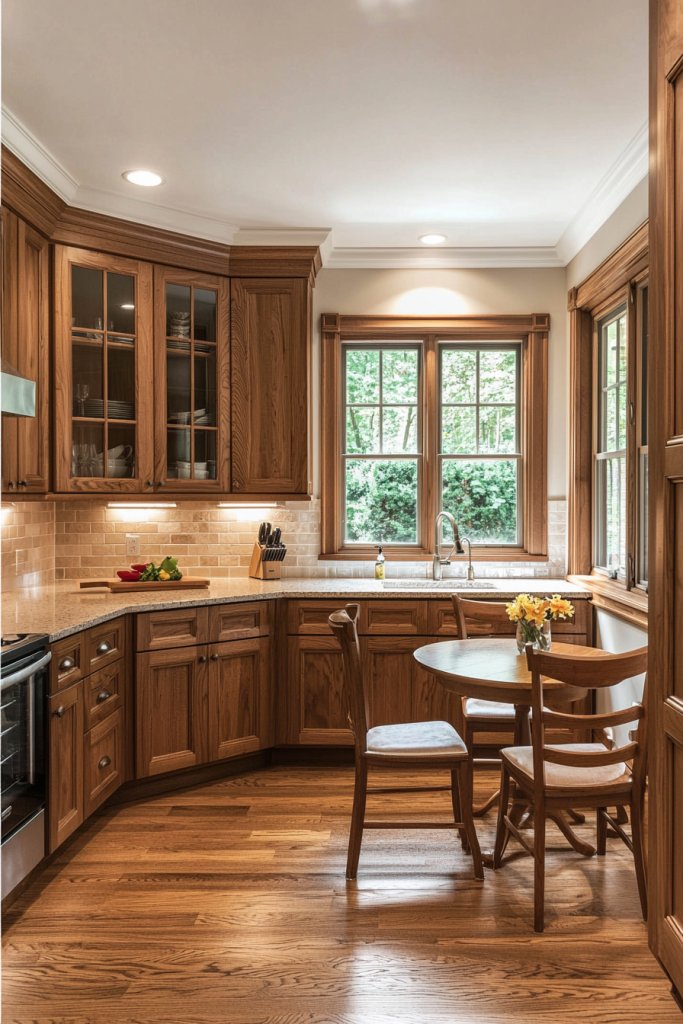
An L-shaped kitchen is a versatile layout that makes the most of corner spaces while creating a cozy dining nook. It combines ample counter space for prep and cooking with a dedicated area for casual dining, making it ideal for small families or those who love a functional yet intimate kitchen.
Envision a kitchen with warm oak cabinets paired with cream-colored countertops forming an L shape. One side houses the stove and sink, while the other extends into a small breakfast nook with a round table and upholstered chairs.
The nook is nestled into the corner, illuminated by a pendant light overhead and decorated with textured cushions and ceramic vases on the table. The overall atmosphere is inviting and practical, perfect for quick breakfasts or relaxed mornings.
To set up this layout, start by positioning appliances along the longer walls to maximize workspace. Incorporate a built-in window bench or a small table with comfortable chairs into the corner for the nook.
Use light-colored cabinetry and wood accents to keep the space feeling open and warm. Opt for compact appliances to save space and consider adding floating shelves for extra storage. This design balances cooking efficiency with casual dining, creating a welcoming, multi-functional space.
4. Island-Centered Kitchen for Multi-Functional Use
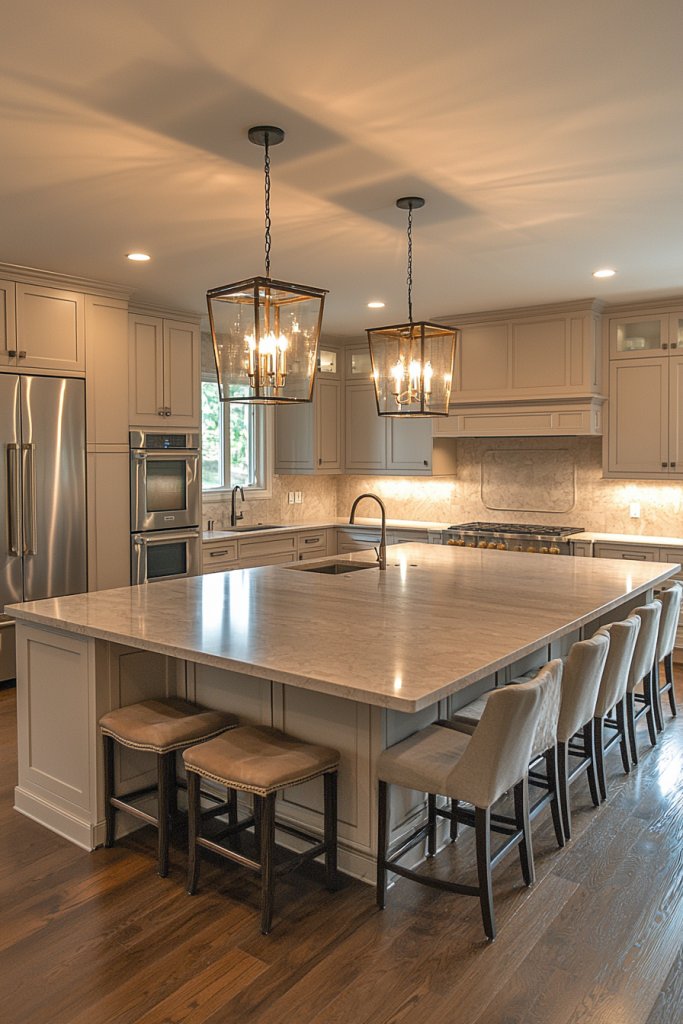
A kitchen centered around a large island is the heart of social and culinary activity, offering multiple functions—from prep and cooking to casual dining and socializing. The island acts as a focal point, fostering interaction and flexibility, making it perfect for open-plan spaces.
Imagine a spacious kitchen with a massive island featuring white marble countertops and overhead pendant lights. The island includes drawer storage, a built-in cooktop, and a waterfall edge that adds visual drama.
Surrounding the island are upholstered barstools for casual meals, while the rest of the kitchen has sleek cabinetry and hidden appliances for a clean look. The space feels lively and inviting, encouraging family or guests to gather around while you cook.
To create this setup, focus on selecting a large, durable island with ample storage and integrated appliances like dishwashers or wine coolers. Use high-quality materials such as quartz or marble for the surface, and ensure there’s enough clearance around the island for easy movement.
Install task lighting overhead, and choose stools that complement your style. This layout is accessible for DIY projects with basic carpentry skills and can be tailored to fit various budgets, transforming your kitchen into a social hub.
5. Peninsula Layout for Open yet Defined Zones
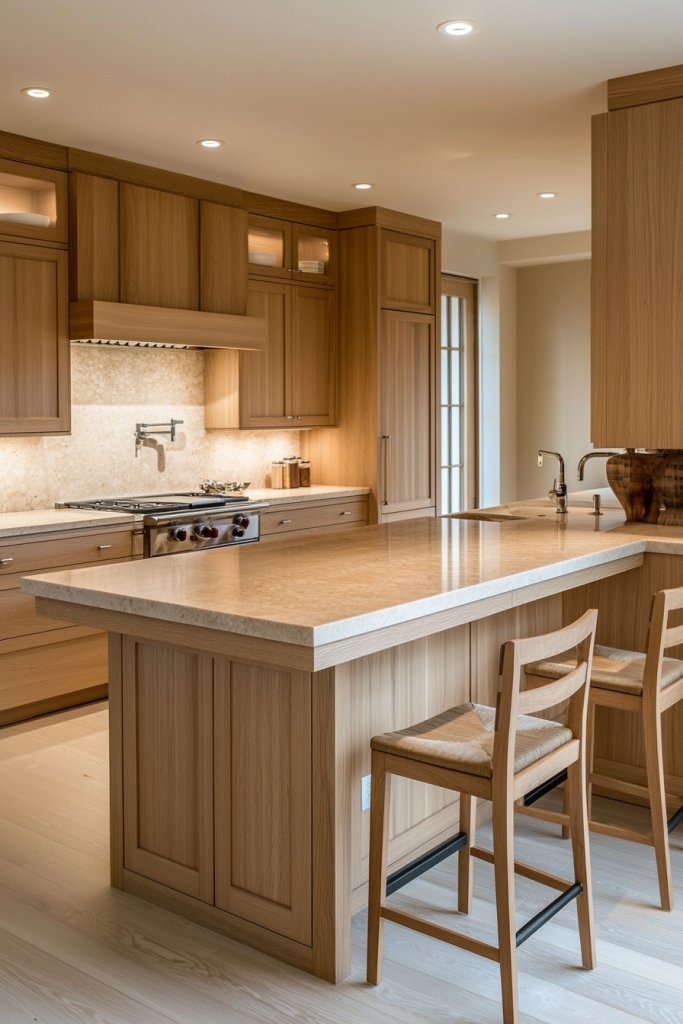
A peninsula kitchen layout masterfully balances an open feel with clearly defined zones, making it perfect for multitasking households. It creates a semi-enclosed workspace that invites social interaction while maintaining distinct areas for prep, cooking, and cleaning.
Imagine a sleek, U-shaped counter extending into the room, forming a partial barrier that separates the kitchen from adjacent spaces. The surface might feature a warm granite or quartz countertop in neutral tones like beige or soft gray, complemented by white or light wood cabinetry for a fresh, airy vibe.
The peninsula can include an overhang with bar stools, encouraging casual dining or conversation. Soft under-cabinet lighting casts a gentle glow, highlighting the textured marble backsplash and giving the space a welcoming ambiance.
The overall design feels open yet organized, with enough room for multiple people to work comfortably without feeling cramped. To recreate this layout, start by measuring your available space to ensure enough room for a peninsula that’s at least 3-4 feet wide.
Choose a durable countertop material such as laminate, quartz, or wood, depending on your budget. Install cabinets that extend from the wall to support the peninsula, and add a bar overhang for seating.
Incorporate task lighting under cabinets and around the workspace for both style and function. Keep the area clutter-free with pull-out drawers and built-in organizers to maximize efficiency. Finishing touches like pendant lights or decorative bowls on the counter can personalize your space while maintaining its open, welcoming appeal.
6. Single-Wall Kitchen for Small Spaces
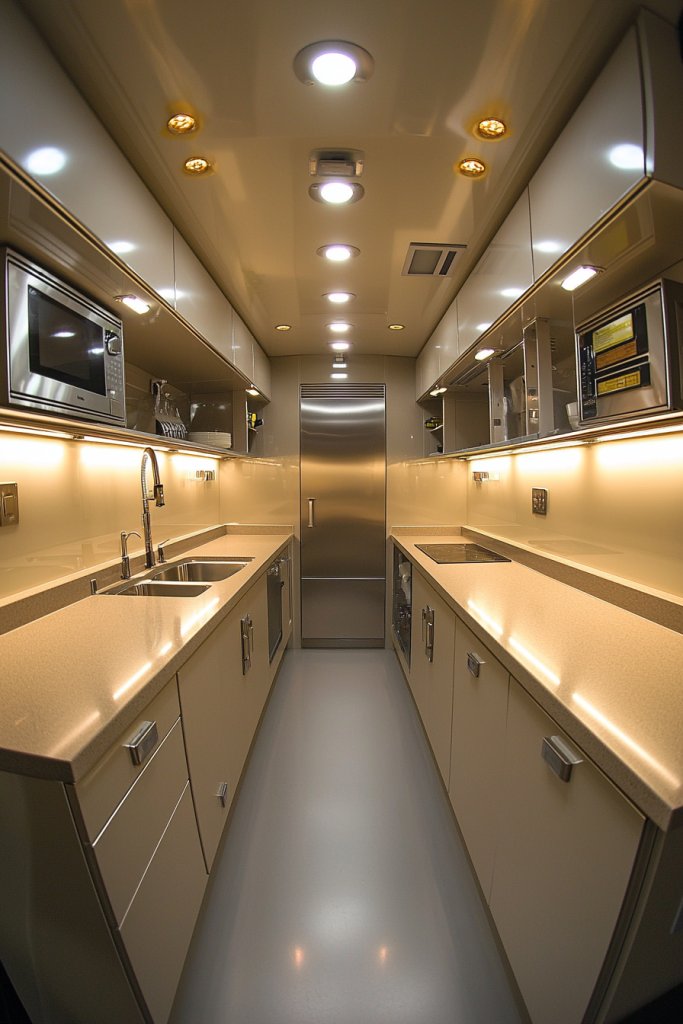
A single-wall kitchen is the ultimate space-saver, ideal for compact homes or open-plan apartments where maximizing floor space is key. It consolidates all essentials into one streamlined line, making the kitchen feel less intrusive while maintaining full functionality.
Visualize a sleek, narrow corridor where all appliances and storage are aligned along a single wall. The cabinets are in a crisp matte white or soft gray finish, offering a clean, modern look.
The countertop, made of stainless steel or laminate, spans the width, with a compact cooktop and under-mount sink integrated into the surface. Open shelving or wall-mounted racks provide easy access to everyday items without crowding the space.
Bright, reflective surfaces like glossy tiles or mirrored backsplash amplify the sense of light and openness. Small decorative touches, such as a colorful cutting board or vase of fresh herbs, add personality without clutter.
To set up this layout, start by measuring your available wall length and selecting compact appliances suited for small spaces, like apartment-sized refrigerators or single-burner stoves. Use wall-mounted cabinets or open shelving to maximize storage without encroaching on the limited footprint.
Install your countertop, ensuring enough workspace for meal prep, and add a small, under-sink trash bin for convenience. Keep the design minimalistic by choosing simple, cohesive hardware and avoiding bulky furniture. This layout is straightforward to assemble and perfect for creating a functional kitchen that doesn’t sacrifice style or space.
7. Double-Wall Kitchen with Symmetrical Storage
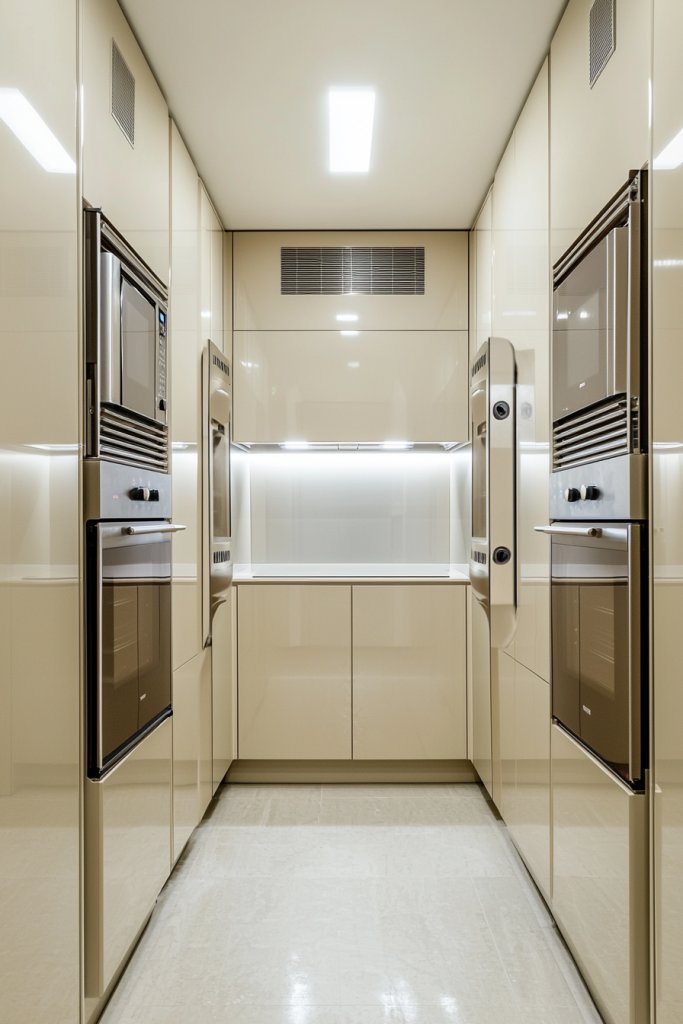
A double-wall kitchen offers a balanced, efficient workspace by placing appliances and storage on two opposite walls, creating a natural flow for cooking and cleaning. Symmetrical storage maximizes organization and ensures everything you need is within easy reach.
Picture two parallel walls, each lined with matching cabinets in a soft, neutral tone like taupe or pale blue. Between them, the countertop runs the full length, crafted from quartz or butcher block—smooth and durable.
On one side, you might have a built-in oven and microwave, integrated seamlessly into the cabinetry. On the opposite wall, a refrigerator and dishwasher fit neatly into the cabinetry, maintaining visual harmony.
Open shelves or glass-front cabinets provide display space for dishes or decorative jars, adding charm. The overall space feels symmetrical and balanced, with ample storage and a clear workflow from prep to cleanup.
The aesthetic can be softened with textured backsplash tiles or warm wood accents. To implement this layout, measure your room carefully to ensure enough space for the appliances and storage.
Select matching cabinetry in durable materials like laminate or wood veneer for a cohesive look. Install pull-out drawers and corner carousels inside cabinets to maximize storage efficiency.
Position your major appliances at ergonomic heights to streamline cooking. Add task lighting under cabinets and around work zones for safety and ambiance. This setup is ideal for those seeking a highly organized, visually balanced kitchen that handles heavy use effortlessly.
8. Modern Minimalist Layout with Clean Lines
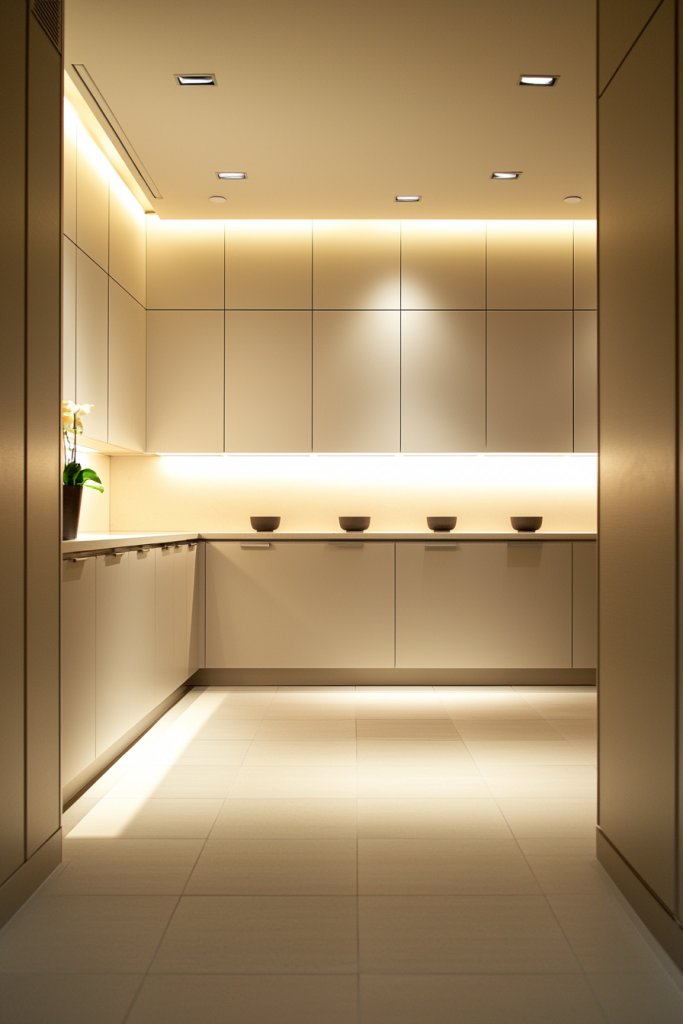
A sleek, clutter-free kitchen design emphasizes simplicity, functionality, and visual calm, making it perfect for contemporary homes. This layout reduces visual noise by focusing on clean, straight lines and smooth surfaces, creating an uncluttered, sophisticated space.
It’s ideal for those who love a tidy aesthetic and want their kitchen to feel open and airy. Imagine an all-white or soft gray palette with handleless cabinets that blend seamlessly into the walls, paired with glossy or matte finishes.
The countertops are smooth quartz or concrete, with minimal adornment—perhaps just a single modern pendant light hanging overhead. The space feels bright and expansive, with hidden storage solutions keeping everything out of sight.
Textures are subtle, with sleek cabinetry and polished surfaces, while lighting enhances the clean, crisp atmosphere. This style exudes modern elegance and promotes effortless organization, making daily routines smoother.
To recreate this look, start with streamlined, flat-front cabinets in neutral tones like white, black, or taupe. Use handleless designs for a seamless appearance, and choose durable, low-maintenance materials such as quartz or concrete countertops.
Incorporate recessed lighting or simple pendant fixtures to highlight the clean lines. Keep surfaces clear of clutter by installing features like pull-out drawers and built-in appliances—think a built-in oven and refrigerator.
Finish with minimalist accessories like a single vase or a sleek utensil holder to maintain the uncluttered feel. This layout is easy to adapt for various space sizes and budgets, making your kitchen feel modern, functional, and effortlessly stylish.
9. Multi-Level Kitchen Design for Zoning and Flow
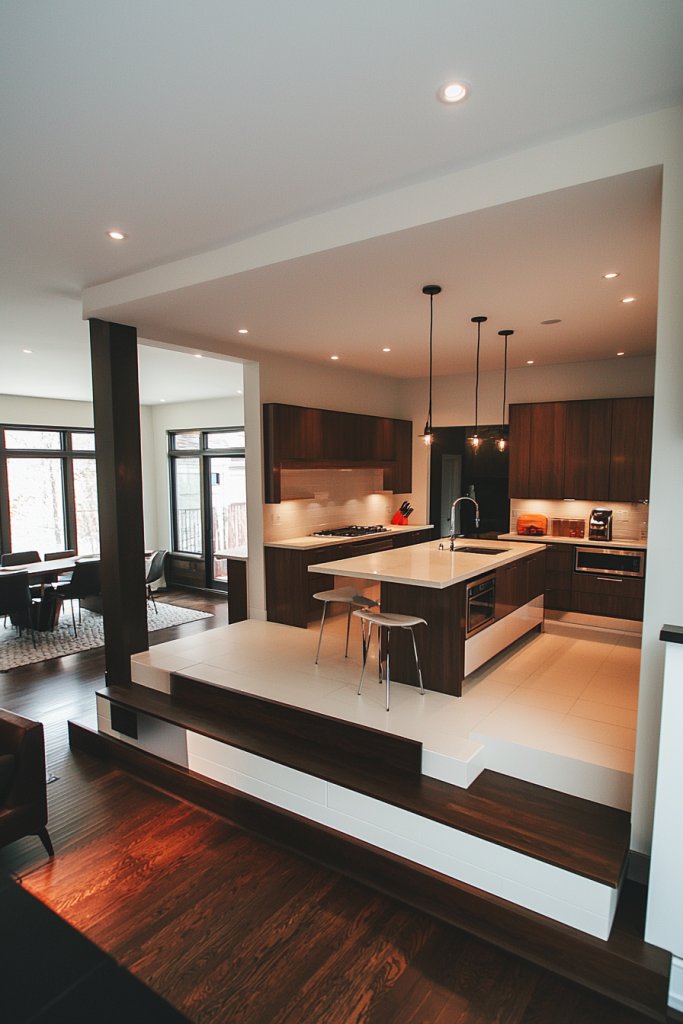
This innovative approach uses different floor heights or subtle level changes within the kitchen to define distinct zones—such as prep, cooking, and dining—while maintaining an overall sense of openness. It adds visual interest and functional separation, helping to organize a busy kitchen without walls or partitions.
Imagine a kitchen where the main prep area is on a slightly raised platform, creating a dedicated space for chopping and mixing, while the cooking zone remains at the original floor level with a sleek stove and ventilation hood. The dining area might be set on a lower level, with a cozy banquette or table nestled into a corner.
Materials like contrasting flooring—such as wood on one level and tile on another—enhance the zoning effect. The design fosters smooth movement between zones, reduces congestion, and creates a dynamic, layered look that invites exploration.
The different levels also help contain noise and clutter, making the space feel more organized and intentional. To implement this concept, start by planning the floor plan carefully, identifying areas that can be slightly raised or lowered with small steps or platformed flooring.
Use contrasting materials or colors to emphasize the different zones, such as hardwood for prep and tile for cooking. Incorporate built-in cabinetry and appliances that fit within each level to maximize efficiency.
Ensure safety by adding handrails or non-slip mats where needed. This layout is versatile and can be adapted to both small and large kitchens, offering a sophisticated way to improve flow and define functional areas without sacrificing openness.
10. Corner Sink and Counter Arrangement for Maximum Efficiency
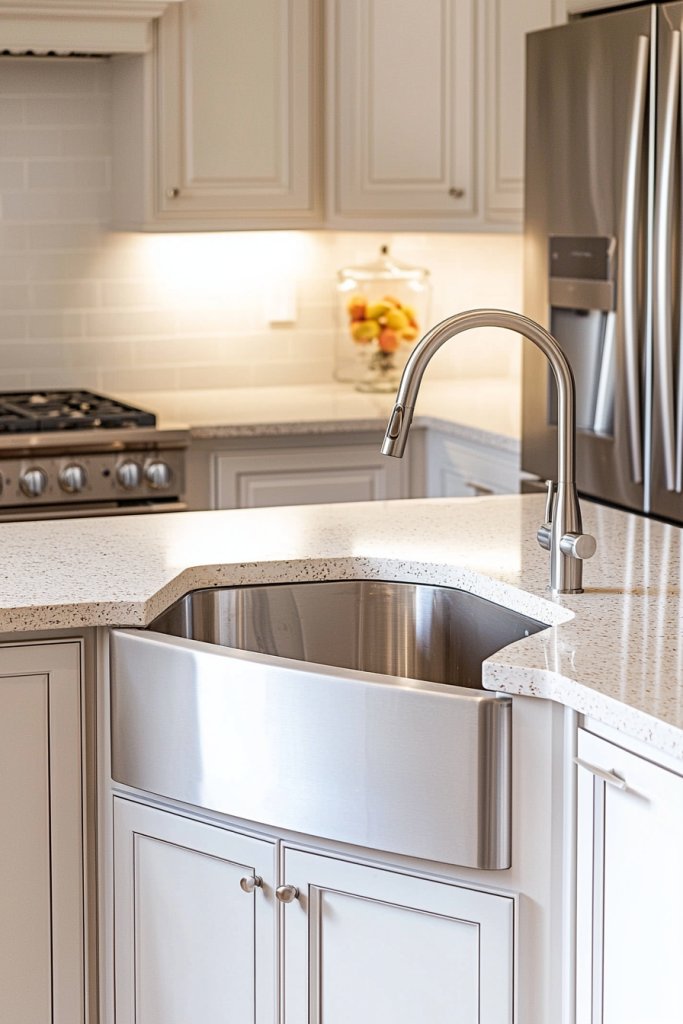
Placing the sink in a corner optimizes space and creates a functional work triangle between the sink, stove, and refrigerator. This layout reduces unnecessary movement, allows for better use of corner cabinetry, and maximizes countertop space—especially valuable in smaller kitchens.
Picture a corner with a deep, sleek stainless steel or composite sink nestled into a countertop that spans two walls. Above, there are cabinets or open shelves for easy access to cleaning supplies and dishware, while below, corner cabinets or lazy Susan storage maximize storage capacity.
The countertops extend on either side of the sink, providing ample room for prep work and drying dishes. The overall layout creates a smooth flow from washing to cooking, with the sink positioned for easy access to both the stove and refrigerator.
It feels efficient, organized, and thoughtfully designed, making even small kitchens highly functional. To achieve this setup, choose a corner sink designed for space optimization, such as a corner or triangular basin.
Use corner cabinet solutions like lazy Susans or pull-out trays to maximize storage. Keep countertops clear of clutter with dedicated space for dish drying and prep.
Install task lighting above the sink area for better visibility. This arrangement is straightforward to implement with common cabinetry options and can be customized with different sink styles or finishes. It’s an excellent way to boost efficiency, especially in compact kitchens, by making the most of every inch of space while maintaining a clean, organized look.
11. Kitchen with Integrated Appliances for a Sleek Look
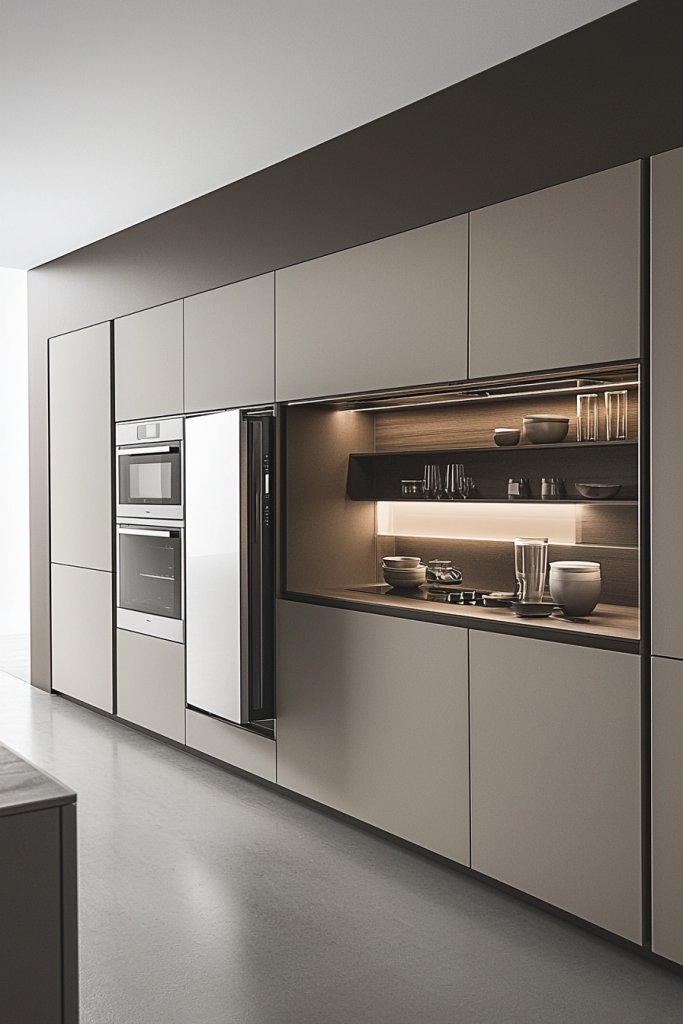
A kitchen with integrated appliances offers a modern, streamlined aesthetic that instantly elevates the overall design. By seamlessly blending appliances into cabinetry, this layout creates a clutter-free, cohesive space that feels both spacious and sophisticated.
It’s perfect for those who love a minimalist vibe and want their kitchen to look effortlessly chic. Imagine a kitchen where the refrigerator, oven, and dishwasher are built into custom cabinetry, with sleek, handleless fronts in matte or high-gloss finishes.
The appliances are concealed behind panels that match the surrounding cabinets, creating a uniform surface that reflects soft natural light. The countertops are smooth quartz or marble, adding to the luxurious feel, while hidden ventilation systems keep the space quiet and clean.
The overall palette might feature neutral tones like warm beige, cool gray, or crisp white, with subtle metallic accents for a touch of elegance. To achieve this look, start by choosing appliances with built-in options that fit your space—such as an integrated fridge or oven.
Next, select cabinetry that aligns with your desired aesthetic, opting for handleless doors or push-to-open mechanisms for a sleek appearance. Measure carefully to ensure appliances fit snugly behind panels, and consider hiring a professional for precise installation. For a DIY approach, use adhesive-backed panels or custom veneer to cover existing appliances temporarily, creating a cohesive look without major remodeling.
12. Flexible Modular Kitchen Layout for Customization

A flexible modular kitchen layout is all about versatility—using movable, interchangeable units that adapt to your changing needs and maximize space. This approach is ideal for homeowners who love to personalize their kitchen or frequently update their interiors, offering a practical solution that evolves with lifestyle and design trends.
Picture a kitchen with separate modules such as a movable island on casters, stackable storage units, and open shelving that can be repositioned easily. The color scheme might feature neutral tones like soft gray or warm wood finishes, complemented by sleek stainless steel accents.
The modular units are made of durable materials like laminate, plywood, or metal, with options to add baskets, drawers, or open cubbies for customized storage. The layout encourages a dynamic flow, with clear zones for prep, cooking, and storage that can be rearranged for social gatherings or family routines.
To implement this concept, start by selecting modular pieces that suit your space—look for lightweight, durable materials like BIFMA-approved metal carts or wooden stacking shelves. Use casters for easy mobility and choose units with versatile configurations.
Sketch your space and plan how each module can be moved or reconfigured for different occasions or tasks. For a DIY upgrade, repurpose existing furniture or storage containers, adding wheels or adjustable shelves to create a personalized, adaptable kitchen environment that can be reconfigured anytime with minimal effort.
Conclusion
With a diverse array of kitchen layout drawing ideas—from open-concept designs and functional U-shapes to sleek minimalism and flexible modular setups—there’s a perfect plan for every space and style. Experimenting with these concepts can transform your kitchen into a seamless, efficient, and inspiring hub for daily life.
Don’t hesitate to bring your vision to life—start sketching, customizing, and creating a space that truly works for you. Your dream kitchen is just a design away!
Leave a Reply